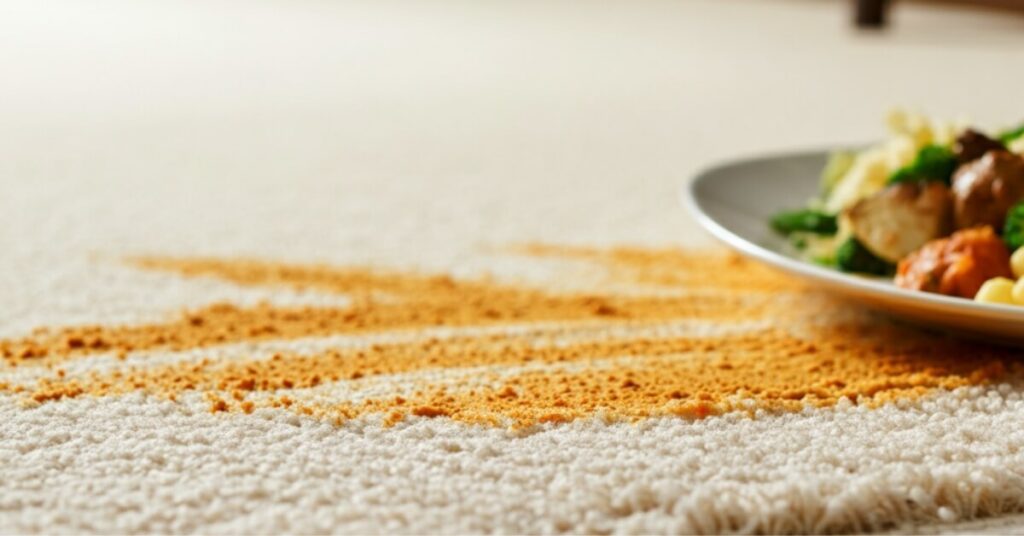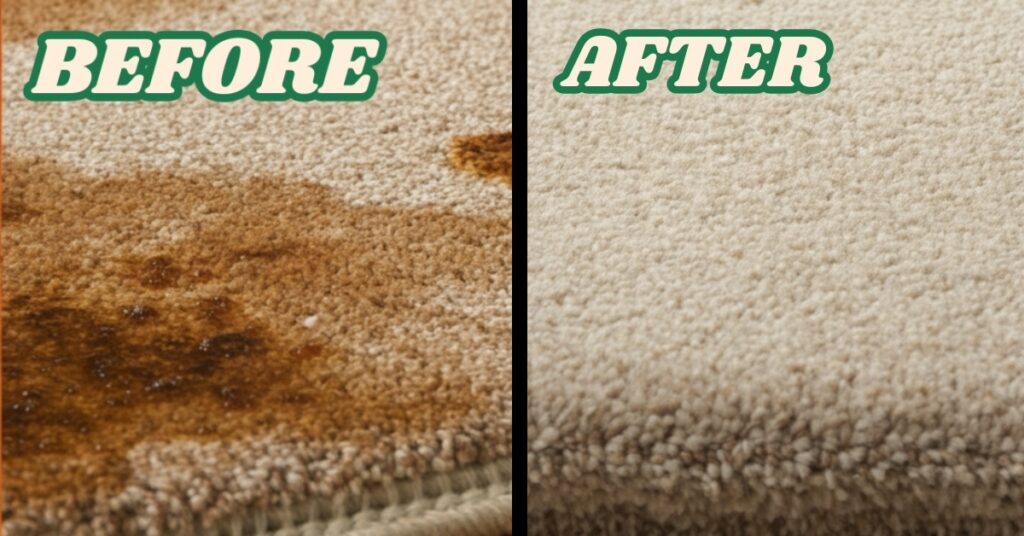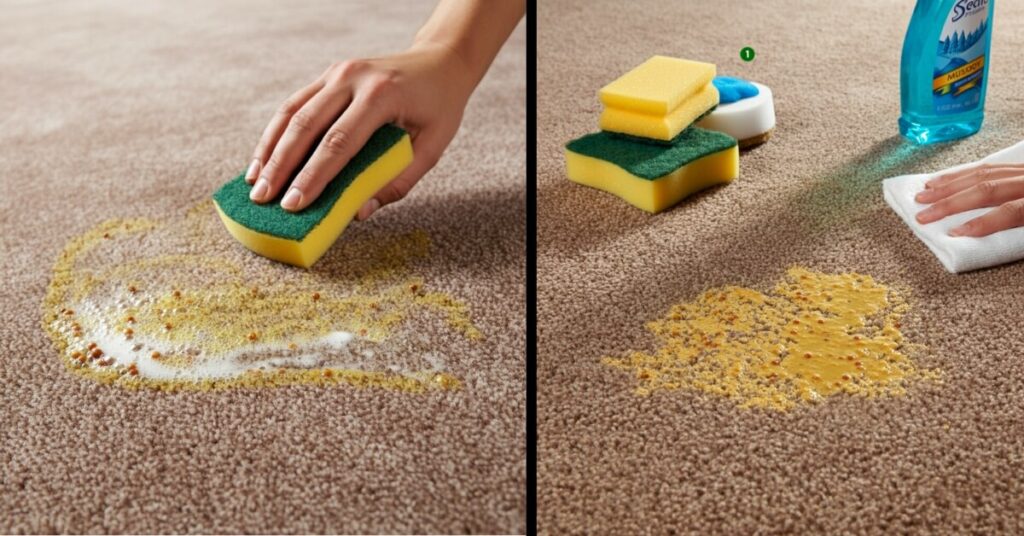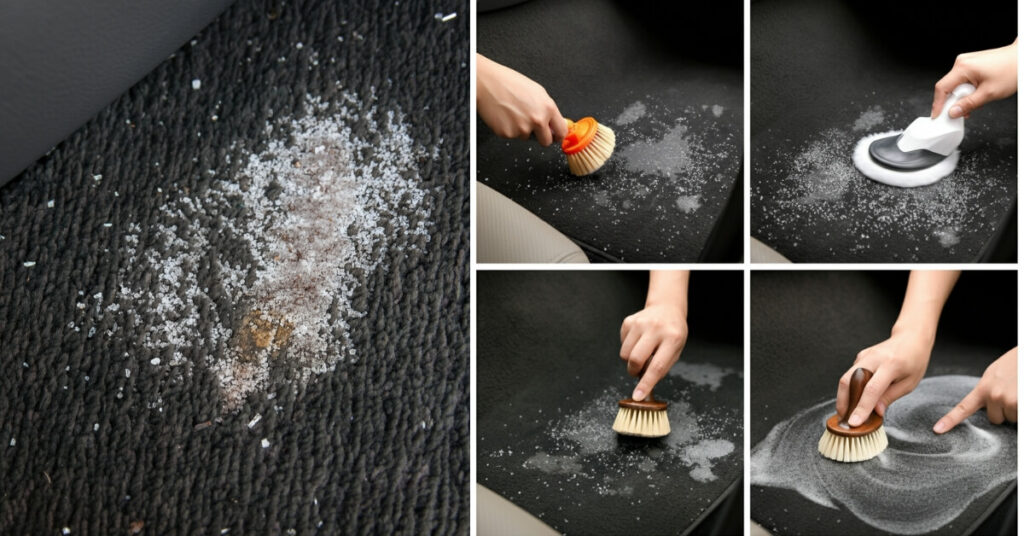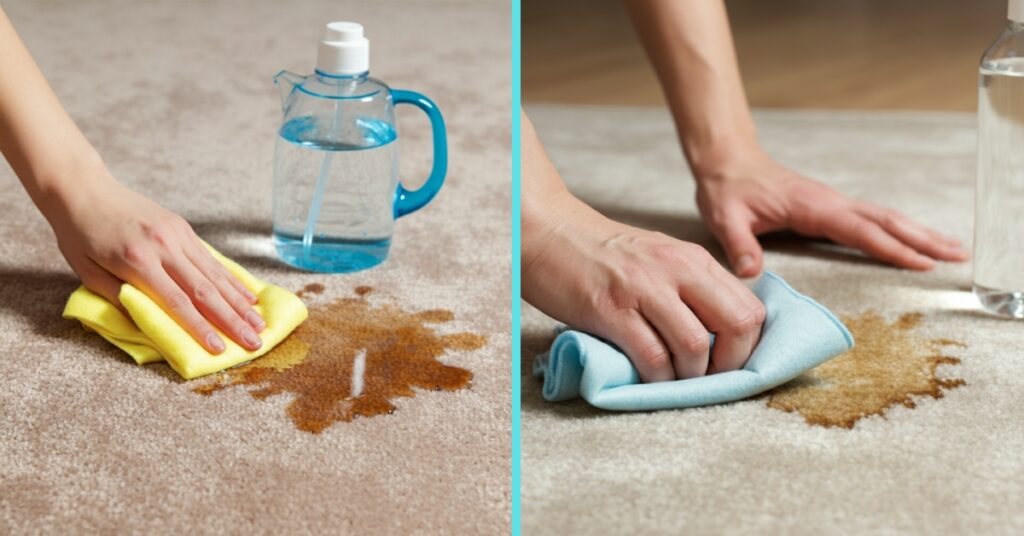As an Amazon Associate, I earn from qualifying purchases.
Yes, you can get curry stains out of carpet—if you act quickly and use the right techniques. When it comes to cleaning curry stains, turmeric is the most stubborn ingredient, as its natural dye properties can leave a deep yellow tint that penetrates carpet fibers. Addressing the stain promptly with targeted cleaning solutions is the key to successful removal.
This guide on how do you get curry stains out of carpet offers straightforward methods to tackle both fresh spills and older, set-in stains. You’ll learn which household products work best, step-by-step cleaning instructions, and practical tips to prevent permanent discoloration. Whether you’re dealing with a light mark or a stubborn patch, this article provides everything you need to restore your carpet’s clean appearance.
Contents Overview
Why Are Curry Stains Difficult to Remove
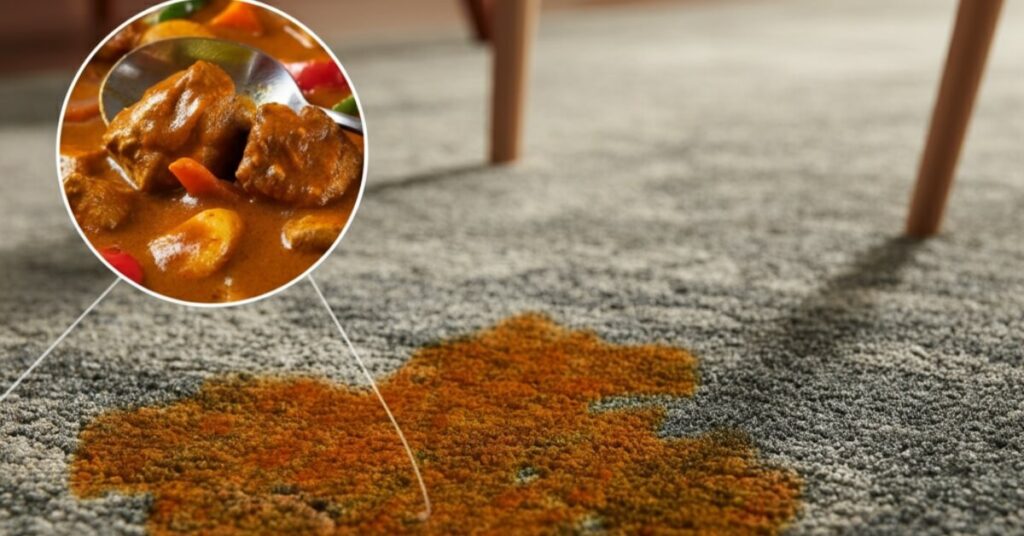
Curry stains are not like other food spills. They include various elements that work in unison to form stubborn, persistent stains such as:
- Turmeric: Most curry stains are turmeric-based. This natural yellow pigment can quickly bond to carpet fibers and, when combined with heat or left untreated, becomes even more difficult to remove. Its bright, beautiful color is not so beautiful if it ends up on your carpet.
- Oil and Fat: Curries are often accompanied by some kind of oil or ghee that seeps deep into the carpet fibers. These oils also make the carpet greasy. Moreover, they make the carpet look dirty, giving the carpet a very hard and unappealing fresh look.
- Spices and Acidity: Other spices, especially chili powder, along with acidic components like lemon juice and tomato, worsen the condition of the carpet fibers, which makes the removal of the stain more difficult. It is also worth noting that the acids can change the pH of your carpeting and will be a cause for long-term discoloration.
Every moment counts when it comes to preventing the pigmentation and oils from setting in. Whether you’re hosting a dinner party or having a quiet meal at home, dealing with curry spills promptly can help you save hours of scrubbing later on. If not treated efficiently, curry can turn into a permanent souvenir of a tasty meal.
What You Will Need To Remove a Curry Stain
To get ahead of a stain, gather some of these essential items. Most of these can be found in your kitchen or pantry. If not, they are budget-friendly and can be ordered online. Here’s a list of powerful stain removers that are safe for carpets:
- Cold water – This helps increase the chances of preventing the stain from setting.
- Dishwashing liquid – A strong, grease-fighting type is ideal to break down any oils.
- White vinegar – A natural and safe product that helps neutralize turmeric and other dyes.
- Baking soda – Great for absorbing odors and providing gentle abrasiveness for tough scrubbing.
- Hydrogen peroxide – Works great for stubborn stains. Always use 3% and test on a hidden area first!
- Clean white cloths or paper towels – Using white ensures that dye won’t transfer onto your carpet.
- Spray bottle or small bowl – Helps with easy mixing and precise application of the cleaning solution.
- Soft-bristle brush, toothbrush, or sponge – Helps to work older stains into the carpet’s fibers.
- Vacuum cleaner – Great for cleanup after everything has dried in order to restore the texture of the carpet.
Carpets are an expensive investment, but with the proper household cleaning items mentioned above, you may not need professional deep-cleaning services.
How Do You Get Curry Stains Out of Carpet
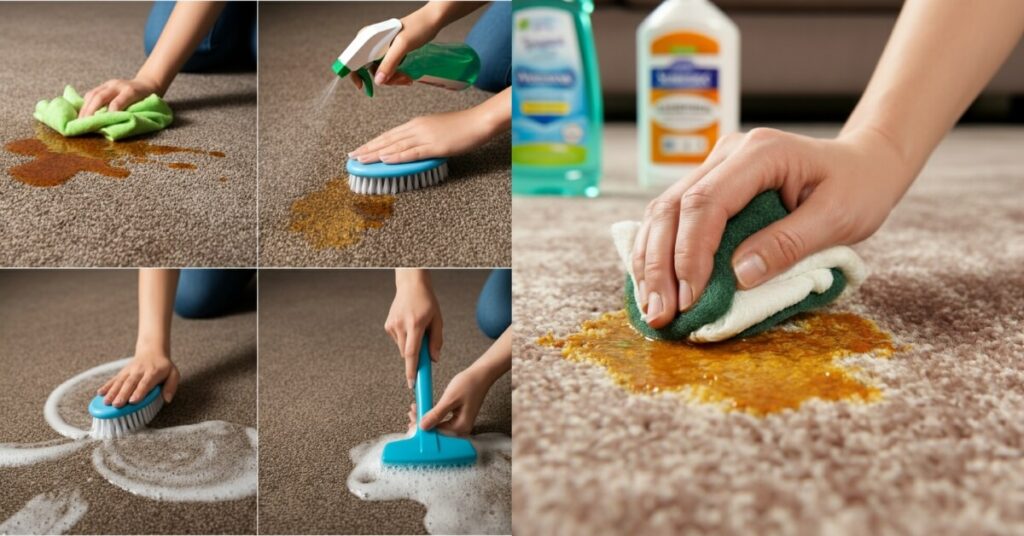
Removing stains is all about being smart, gentle, and using the right techniques. Follow these steps to keep your carpets looking fresh and healthy while eliminating the stains.
Step 1: Blot the Fresh Stain Immediately
The curry stain will become increasingly difficult to clean if it is not addressed as soon as possible. Take a clean, white cloth or paper towel and dab at the spill gently; this will ensure that you absorb as much of the curry as possible.
Avoid scrubbing or rubbing as this will make the situation worse, increasing the area of the spill and pushing it deeper into the carpet fibers. Rather, press down gently, lift, and repeat until the majority of the spill is absorbed. Any solid remnants can be delicately removed using the edge of a spoon or spatula.
Pro tip: To minimize the chances of spreading the stain, always work from the outside towards the center.
Step 2: Rinse With Cold Water
Now that you have soaked the area with a clean towel, gently spray (or pour) a small amount of cold water on the area. Cold water helps dilute the pigment and prevents the turmeric from setting into the fibers, which can happen quickly with warmth.
Blot with a fresh towel and don’t forget to repeat the process with fresh towels until the color transfer stops. Remember to never fully soak the carpet, keep it damp, not drenched.
Step 3: Apply a Dish Soap Solution
Grease-cutting dish soaps work particularly well for oily curry stains. You can make a spray or bowl solution with:
- 1 teaspoon of dishwashing liquid
- 1 cup of cold water
To remove the stain, soak a clean cloth in the solution or spray it directly onto the stain. Gently blot (do not scrub) the curry stain with light, but firm pressure. The dish soap will lift and separate the oils, enabling the colored pigments to be absorbed into the cloth.
If the stain is deep or large, you may need to repeat blotting with fresh solution and clean towels many times. It’s completely normal to see yellow on your towels, which means the ingredients are working.
Step 4: Use Vinegar for Yellow Stains
To alleviate yellow stains, try this vinegar solution:
- 1 part white vinegar
- 2 parts cold water
Spray or gently blot the mixture onto the stain, then wait for 5-10 minutes. The yellow tint turmeric gives carpets is broken down by the vinegar, making it effective in removing the yellow coloring. After blotting, use a clean, dry towel to blot again.
To some extent, this process can be repeated. In some cases, a second or third try may help lift even more color as the vinegar continues to react.
Optional: For enhanced stain-fighting capabilities, sprinkle a light layer of baking soda over the vinegar mixture and allow it to fizz for a few minutes. This is especially helpful for older, more stubborn stains.
Step 5: Treating Stubborn Stains with Hydrogen Peroxide
For persistent yellow stains lingering after several cleaning attempts, use hydrogen peroxide (3%). Be sure to check for discoloration first on a hidden area before applying it to the rest of the carpet.
- Use a mixture of 1 part hydrogen peroxide and 1 part cold water.
- Blot the stain with a clean cloth dipped into the solution. For more stubborn stains, blot and leave the cloth for 5-10 minutes before blotting again.
- Pay attention to the changes as you go: hydrogen peroxide is a natural oxidizer, so it will lighten darkened carpets over time.
You can repeat these steps, but always remember to rinse the area with plain water after using hydrogen peroxide, then blot dry.
Step 6: Rinse and Dry
After stain removal, quick rinsing is important. Stains or dirt are best cleared with a gentle spray or light splash of water to remove any remaining cleaning solution. Thoroughly blot the area with a clean towel or wipe.
- Drying: Set a small fan to blow air over the area or open windows to promote drying. It’s best to avoid walking over the cleaned area until it’s completely dry. Taking the proper steps as outlined in our guide on how to dry carpet after cleaning can help prevent mold, foul odors, and re-soiling.
- Post-cleanup: The area can be vacuumed in order to blend the cleaned area with the rest of the carpet, restore the pile, and smooth the area.
How to Deal with Older Curry Stains?
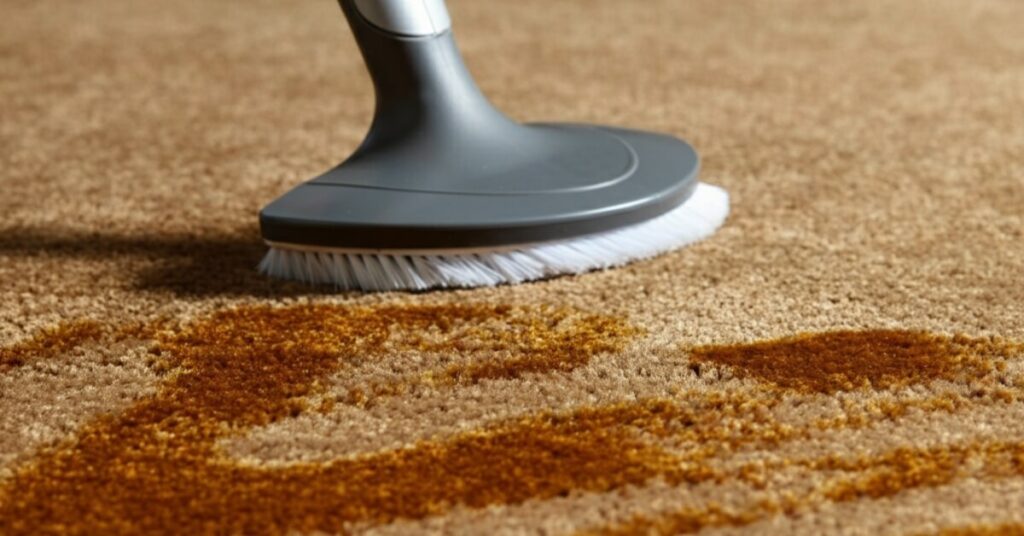
In removing dried curry stains, one requires extra patience and strategies. Here’s what you can do:
Rehydrate the Stain
Firstly, soften the aged stain by using a solution of vinegar and water in the ratio of 1:2. Spray well and let it sit for 10-15 minutes. This helps break down any residue that has hardened over time using vinegar and water makes it easier to remove with cleaning agents.
Implement Stain Remover Procedures Rigorously
Repeat the process of using soap and vinegar, giving it more time. Older stains usually require a minimum of two to three rounds of attempted cleaning. With the aid of your soft-bristle brush, scrub gently around those hard-to-reach areas that are difficult to clean.
Use of Hydrogen Peroxide With Guidance
Use hydrogen peroxide for more challenging areas, the same way it was shown before. Depending on the severity of the stain, it may take more than one or two cycles of application and soaking to fully remove it.
Think About Hiring A Professional
If all steps have been done but there are no results, then it might be time to re-evaluate your strategy. A professional carpet cleaner can be consulted. Modern steam cleaners and enzyme-based solutions are capable of cleaning what household items cannot.
5 Tips To Avoid Getting Curry Stains
To preserve your carpet, you will need to avoid all fresh stains. Regular curry eaters, as well as hosts, should take into account the following methods to keep their homes hassle-free:
1. Provide Mats Under The Dining Furniture
Purchase machine-washable rugs or mats. It is advisable to place them under the dining table, kitchen table, or other locations prone to snacking. These areas are very easy to maintain and help prevent deep stains.
2. Clean Up Food Spills Immediately
Cleaning up any food spills immediately is a helpful habit to get into. Having towels handy helps with the quick collection of stains that, if left unattended, clog the carpet’s fibers. Timely intervention can save your carpet from serious damage.
3. Apply Fabric Protectors
Carpeting and upholstery protectors are helpful when applied every six months. They give an added measure of protection when dealing with liquids by slowing down penetration and allowing more time to clean a mess.
4. Encourage Diners to Sit Outside Carpeted Regions
With young children or during large events make dining and snacking a confined exercise while avoiding carpeted areas. Not only will this assist with curry stains, your carpet will last longer overall.
5. Stick to a Regular Vacuuming Schedule
Regular vacuuming helps in getting rid of stray food particles and dirt that may lead to permanent stains. Make it a point to vacuum once per week and more frequently if meals are served on carpets.
Final Thoughts
Although curry stains might seem like the worst thing for your lovely carpet, worry not – with this guide, even the most stubborn yellow stains won’t stand a chance! Your carpet can look as good as new after some quick response blotting and the smart use of vinegar, dish soap, and hydrogen peroxide.
Everyone faces spill accidents, but with the right approach and careful prior planning, your carpet can remain in tip-top shape throughout the years. Don’t let a curry incident ruin your interior: act quickly and follow the steps mentioned above to remove the unwanted stains, preserving your meals without any concerns.
Carpet FAQs About Curry Stains
1. Does turmeric permanently stain carpet?
Yes, turmeric is known for permanently staining light carpets. However, with fast action using dish soap, vinegar, and hydrogen peroxide, most carpets can be saved. Never use hot water for turmeric stains, as it sets the color.
2. Can I use bleach to remove curry stains?
No. Bleach is far too harsh and can quickly damage carpet fibers, sometimes turning yellow stains even more pronounced. Instead, stick with safe, gentle cleaners and always perform a spot test before trying anything new.
3. Will vinegar remove curry stains?
Yes, white vinegar is very effective for neutralizing the yellow pigment in turmeric. When combined with cold water and blotting, vinegar helps pull the stain to the surface for removal. For persistent stains, combine vinegar with baking soda for extra cleaning power.
4. How long does it take to remove a curry stain?
Most fresh stains can be treated within 15–30 minutes with the above steps. Old or deeply set stains may require repeated cleaning cycles over several hours or even a few days if you’re letting solutions sit in between treatments.
5. What if the stain doesn’t come out?
If, after several rounds of cleaning, yellow discolouration remains, don’t lose hope. Some stains simply respond better to professional carpet cleaners who use high-strength and steam-based techniques.
6. Can I prevent stains with regular carpet maintenance?
Yes! Frequent vacuuming, protective sprays, and area rugs go a long way in reducing the frequency and severity of stains. Maintenance not only keeps your carpet looking good but also extends its lifespan.
As an Amazon Associate, I earn from qualifying purchases.
